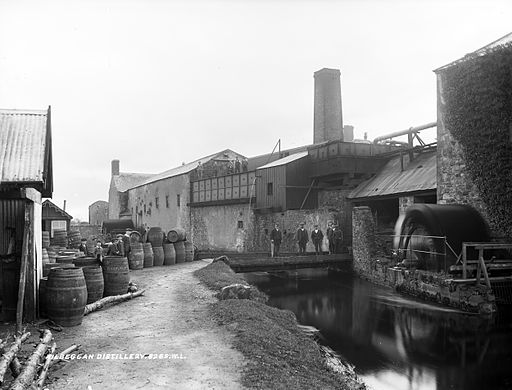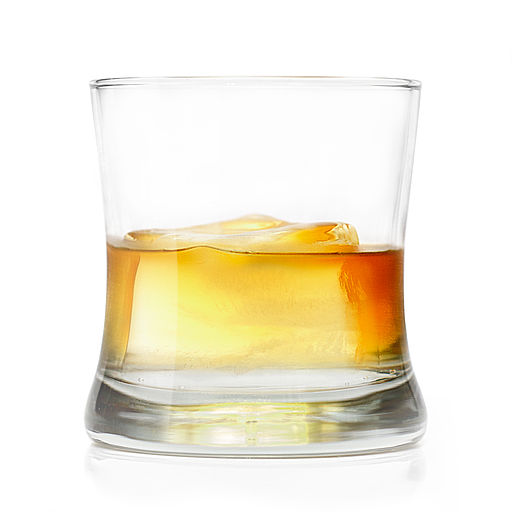Angel's Share: A Whisky Story

England proved to be extremely hospitable to a young girl sporting a broad grin and an oversized army-issue rucksack. The famous fog and grey dripping skies were nowhere to be seen. I was able to sleep outdoors, or on offered couches or in the rec rooms of hostels, curled up, boots on, as if I had fallen asleep after one too many evening pints of bitter.
In the morning, while the real drinkers were still deep in their post-cup slumbers, I would slip my backpack from behind the sofa and make my way back onto the road. The road cut southward down from Manchester, through the countryside, into Stratford. I caught a ride into town with a newly wed Indian couple. The man, only five years older than me, asked if I wasn’t afraid to be traveling alone. I looked at his wife, only three or four years older than me, and back at him. “No, Mate,” I replied, stepping out of the back seat onto the warm black pavement. “I’m not that smart.”
SEE ALSO: A Tranquil Setting For An Extreme Organism
Outside of Stratford, east towards the somewhat menacing steel gray tower of Warwick castle, a bend in the wheat-fields led to a brewery. I knew it was a brewery by the smell. It smelled like a truck-load of spirits had crashed while taking the curve about, oh, two months back, and the locals were taking their time on the clean-up. The smell carried over the head-bowed, flax-golden fields with a subtle fury. It was strong, sweet-and-sour all at once. There was a slight after-tinge of cooking fuel.
As I strode closer, brown leather boots crunching over the grey gravel, I began to see a change in the trees. To my left and my right, they were covered in an uneven black layer like someone had thrown paint on every tree between the brewery—or distillery, as it turned out to be—and the road. The paint was only on one side—the windward side—and extended no higher than the roof of the distillery. At the edges, it faded away, rubbed out, like an afterthought or an incomplete sentence.
The closer I grew to the dark-roofed one-story building set in the middle of the field, the thicker the black layer became. When I was nearly to the door, what I saw made me think that I was imagining things. Then a troll-sized, barrel-shaped Englishman appeared out of nowhere at my right side and said merrily, “It’s alright, my dear. The roof is SUPPOSED to be like that. There’s a saying in the whiskey business—a black roof means a whiskey worth drinking!”
Then, I knew I was imagining things.
What the heck did a black roof have to do with whiskey? I was only 16, and most of my experience of whiskey came from sips of glasses graciously extended by adults who had far better taste than me—the present me, who is now the age that many of them were then. I was used to GOOD whiskey. Stuff that lived behind darkened cabinet doors and, later, in singular crystal tumblers with a solitary piece of cubed ice for company. Why, and how, could such a well-groomed substance turn a roof and much of the surrounding forest the color of soot?
The gnome-ish man, who went by the name of Kevin as it turned out, invited me inside. When the stable door closed behind us, I was able to make out figures moving in the dimness. They were closer to my age than to Kevin’s, wearing suspenders and overalls, and doing important things with hoses and spigots. Also, there was chanting.
The chanting was not from the workmen, but being piped in through the intercom system above them. I looked up for the source of the Gregorian voices. I was greeted not by hooded monks but by ruddy-cheeked adult angels, flying across the painted blue walls. “They noticed that the whiskey was vanishing,” Kevin told me, as I eyed the angels’ flight over the whiskey barrels with some suspicion, “The Monks did. Way back then. So they figured - ‘oh, for every amount we make, the angels take some’. That’s ok. We painted them here on the walls for good luck.”
“And, the, um-,” I didn’t want to say Church music. I didn’t know how the the god-plus-booze combination tasted to the English pallet. Distasteful? Sinfully delicious? “-the, uh, chanting?”

“Sure it is,” I replied, and set my bag down. In the course of the evening, I received several generous samples of that angel-eyed, chant-infused elixir and spend a very happy night asleep in the field out back, among the dark trees with their south-facing sides in permanent shadow. It didn’t occur to me that night, or once in the 20 years since, that I was asleep in the midst of a mystery.
Then, along came, “Angel’s Share”. At first, I didn’t believe that such a topic was article-worthy. After all, didn’t everyone leave home at a young age with a backpack in order to wander aimlessly in the world until they accidentally ran into a whiskey distillery where the helpful staff explained why the roof was black? No? Oh, OK.
I’m beginning to see the point of this article now...
In all seriousness, I still can’t believe that the proprietors of Hiram Walker DIDN’T know that it was the whiskey feeding the mold.
In 1995, Kevin and his crew seemed to take this information for granted: the mold grew where the whiskey was kept, and lived, somehow, on the vapors. This booze-“blackstuff” relationship was conveyed to me matter-of-factly, as if it were ancient brewer knowledge passed down through generations, like the very concept of the angel’s share itself. Cause and effect. Done and done.
I could never have imagined the controversy, the complexity and the sheer tenacity of this mystery.
Rogers packaged, presented and then unpackaged the problem very, very well. He opened with the setting: very visual, compelling and clear. Then, he presented the complexity. Then, Rogers backed off from the complexity: ALL the way back, to a glass of fruit juice. To a still. To the 18th Century. And forward. Slowly, steadily, he marched forward through time. There’s a lot of detail there. Right about the time we get to the birth of the economic ecosystem of alcohol, when the average reader is about to ask to be dismissed because his or her brain is full, in walks this wacky mycologist.
Narrative saved by a fungi-o-phile. I love it.
Angel’s Share is a fun adventure. You walk away feeling energized-like you won something; not just something for yourself but something for all of humankind.
That’s a good day in science, a good day in medicine, a good day in writing. It’s a good day walking through the world with a mind open and ready to encounter gnomes, half-blackened trees, and the music of monks mixed with heady vapors slipping from wooden barrels sleeping in the shadow of angels.
Reach contributor Sheyna Gifford here. Follow the Science Desk here.



